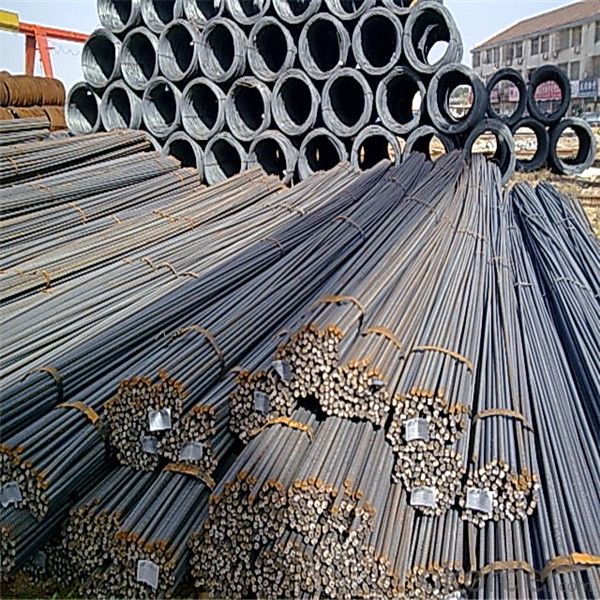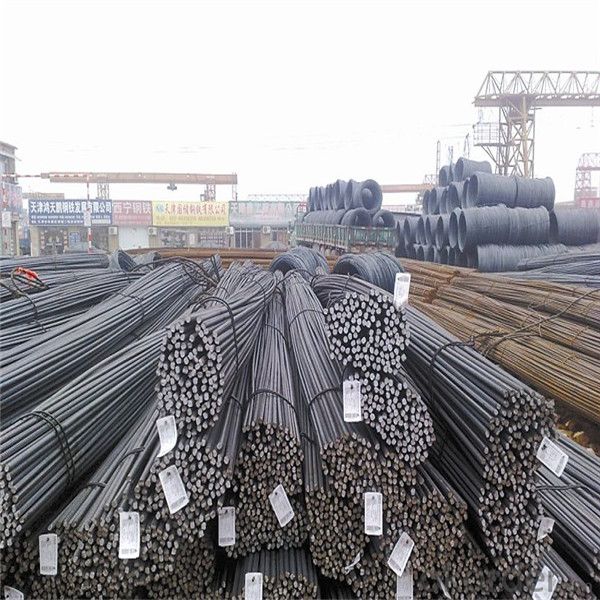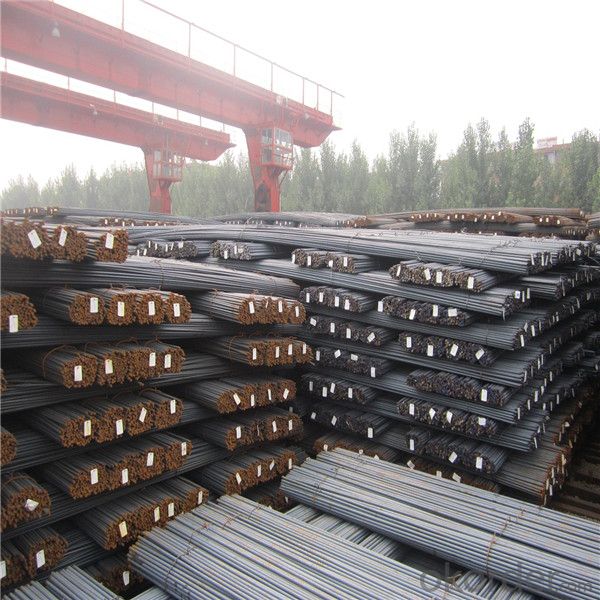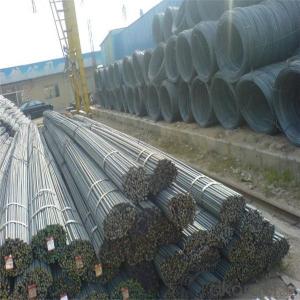Steel rebar from china 6-40MM in different grade
- Loading Port:
- Tianjin
- Payment Terms:
- TT OR LC
- Min Order Qty:
- 1000 m.t.
- Supply Capability:
- 17497 m.t./month
OKorder Service Pledge
OKorder Financial Service
You Might Also Like
Item specifice
Bars of steel commonly used in construction, especially for reinforcing concrete structures such as driveways,
foundations, walls, and columns. These bars come in different sizes and strength grades, and can be smooth
or may include deformations that provide greater adhesion for concrete poured over the bars. When used in poured
concrete, the bars are typically placed in a grid pattern, the concrete poured over them, and then readjusted to
maintain the proper shape while the concrete sets. Steel rebar can be purchased from a number of manufacturers
and is often found at construction retailers or large hardware stores
Most grades of steel used in rebar cannot accept welding; such as, to adjacent steel plates or as means to bind
single pieces of rebar together. However, special grades of rebar steel and welding rods make welding by expert
welders possible.
To prevent workers from accidentally impaling themselves, the protruding ends of steel rebar are often bent over or
covered with special plastic "mushroom" caps.
Product Description :
Chemical composition (%): | Steel | C | Si | Mn | P | S | Ceq | ||||
HRB335 |
0.25 |
0.80 |
1.60 |
0.045 |
0.045 | 0.52 | |||||
HRB400 | 0.54 | ||||||||||
HRB500 | 0.55 | ||||||||||
Mechanical properties | Steel | Rel/ MPa | Rm/ MPa | A/ % | Agt/ % | ||||||
≥ | |||||||||||
HRB335 | 335 | 455 | 17 |
7.5 | |||||||
HRB400 | 400 | 540 | 16 | ||||||||
HRB500 | 500 | 630 | 15 | ||||||||
Package: | Standard export packing or as customer's request | ||||||||||
Application: | Construction, building, bridge, road. ect | ||||||||||
Payment terms | 1).100% irrevocable L/C at sight. | ||||||||||
Delivery time | 15-30 days after receipt of L/C or deposit by T/T | ||||||||||


Features
1、Pure steel quality, stable chemical contents, small tolerance.
2、Constant Quality, good drawing performance.
3、High dimension accuracy degree, accuracy degree of Level C up to 80%, smooth surface, less scale, easy to be pickled.
4、Automatic bundling with 4 lines by Machine in tidy and good looks
5、Big high quality percentage, small coil percentage, and heavy coil weight for Hard Coil.
6、High sorbitizing percentage.
Packing:
In bundles, each bundle weight 3.5 tons. Load by container or by bulk verssel.


FAQ:
1.Q: What's your MOQ(minimum order quantity)?
A: One full container, mixed acceptable .
2. Q: What's your packing methods?
A: Packed in bundle or bulk ..
3. Q: How can I buy CNBM products in my country?
A:Please send us an inquiry or email ,we will reply to you if there is distributor in your country
4. Q: Can we visit your factory?
A: Warmly welcome. Once we have your schedule, we will arrange the professional sales team to follow up your case.
5. Q: How long does it take to get the product if i place an order?
A:With the process of your requirements,we will pack and deliver in 3-7 days. If it is by sea shipment,it will take 15-45 days depending on different locations
- Q:How do steel rebars contribute to the ductility of reinforced concrete structures?
- Steel rebars contribute to the ductility of reinforced concrete structures in several ways. Ductility refers to a material's ability to deform under stress without fracturing. In the case of reinforced concrete structures, steel rebars provide the necessary tensile strength that concrete lacks, enabling the structure to withstand the forces of tension and compression. Firstly, steel rebars effectively resist tensile forces. Concrete is strong in compression but weak in tension. By adding steel rebars within the concrete, the structure gains the ability to withstand tensile stresses. When the concrete is subjected to tension, the rebars carry the load and prevent the concrete from cracking or failing. This enhances the overall ductility of the structure by allowing it to deform and absorb energy without catastrophic failure. Secondly, steel rebars act as reinforcement by distributing applied loads across a wider area. When a reinforced concrete structure is subjected to a load, the stress is transferred from the concrete to the rebars. The rebars distribute this stress throughout the structure, reducing localized concentrations and preventing sudden failure. This redistribution of stress promotes the ductility of the structure by enabling it to flex and absorb energy, rather than experiencing brittle failure. Moreover, steel rebars also provide anchorage and confinement to the concrete. The rebars are typically embedded in the concrete, creating a bond between the two materials. This bond enhances the overall strength and ductility of the structure by preventing the rebars from slipping or pulling out under tension. Additionally, the confinement effect of the rebars prevents the concrete from expanding or spalling under stress, increasing the overall ductility of the reinforced concrete structure. In summary, steel rebars contribute to the ductility of reinforced concrete structures by providing tensile strength, redistributing stress, and offering anchorage and confinement to the concrete. By reinforcing the weak areas of the concrete and allowing for controlled deformation, steel rebars enable the structure to absorb energy and withstand external forces without catastrophic failure.
- Q:Can steel rebars be used in the construction of railway or subway systems?
- Yes, steel rebars can be used in the construction of railway or subway systems. Steel rebars provide structural reinforcement and strength to the concrete structures used in railway or subway construction, making them essential for ensuring the safety and longevity of these transportation systems.
- Q:Can steel rebars be used in parking garage construction?
- Yes, steel rebars can indeed be used in parking garage construction. Steel rebars are commonly used as reinforcement in concrete structures, including parking garages, to enhance their strength and durability. The rebars help to reinforce the concrete and prevent cracking or collapsing under heavy loads, making them an essential component in parking garage construction.
- Q:What is the role of steel rebars in road bridge construction?
- Steel rebars play a crucial role in road bridge construction as they provide reinforcement and strength to the concrete used in building the bridge. They help to distribute the load and forces evenly, enhancing the structural integrity and durability of the bridge. Additionally, rebars prevent the concrete from cracking or breaking under heavy loads, ensuring the safety and longevity of the bridge.
- Q:How do steel rebars affect the overall thermal expansion of concrete structures?
- The overall thermal expansion of concrete structures can be significantly influenced by steel rebars. Concrete exhibits a comparatively low coefficient of thermal expansion, resulting in less expansion and contraction when exposed to temperature changes in comparison to other materials. Conversely, steel rebars possess a higher coefficient of thermal expansion than concrete. When temperature fluctuations occur, such as during hot or cold weather, the expansion or contraction rates of the steel rebars differ from those of the surrounding concrete. This disparity in thermal expansion rates can generate internal stresses within the concrete structure. If not adequately addressed, these internal stresses may lead to cracking or even structural failures. In order to mitigate the effects of thermal expansion, engineers incorporate appropriate reinforcement, including steel rebars, into the design of concrete structures. The presence of rebars aids in distributing the stresses resulting from temperature changes more evenly, thereby reducing the likelihood of cracking or damage. Furthermore, the tensile strength of steel rebars enables them to withstand the forces produced by the differential expansion, ensuring stability for the overall structure. Nevertheless, it is essential to recognize that the effects of thermal expansion cannot be completely eliminated solely by steel rebars. Other factors, such as the inclusion of expansion joints in the design and the utilization of proper construction techniques, also play a crucial role in minimizing the impact of temperature fluctuations on concrete structures.
- Q:How are steel rebars stored and transported on-site?
- Steel rebars are typically stored on-site in bundles or stacks, either horizontally or vertically, with adequate spacing between each bundle to ensure stability and easy access. To transport them, rebars are usually loaded onto trucks using cranes or forklifts, secured with straps or chains to prevent movement or falling during transportation. It is important to handle and store rebars properly to prevent damage or accidents and ensure their quality and structural integrity.
- Q:How do steel rebars help in reducing construction time?
- Steel rebars contribute to the reduction of construction time in several ways. Firstly, they enhance the strength and durability of concrete structures, enabling builders to employ quicker construction techniques. This obviates the necessity for slower and more time-consuming methods as the rebars provide sufficient support for the structure's weight. Secondly, the reinforcement of concrete with steel rebars enhances the overall structural integrity of the building. Consequently, builders can employ thinner concrete sections without compromising the structure's strength. These thinner sections require less material and can be poured and cured more rapidly and easily, thus saving construction time. Thirdly, the installation of steel rebars is a speedy process due to their easy handling and installation characteristics. They can be conveniently cut and bent to fit the desired shape and size, facilitating efficient installation. Consequently, the requirement for complicated and time-consuming formwork is eliminated, resulting in a reduction in construction time. Fourthly, steel rebars offer design and construction flexibility, enabling the utilization of innovative and efficient building techniques. They can be utilized in a variety of applications, including beams, columns, and slabs, granting architects and engineers the freedom to design structures that can be rapidly and efficiently constructed. Lastly, steel rebars provide additional resistance to natural disasters such as seismic activity and extreme weather conditions. By reinforcing concrete with rebars, structures become more resilient, reducing the risk of damage and expediting the construction process. This is particularly crucial in areas that are prone to earthquakes or adverse weather conditions. In conclusion, steel rebars play a pivotal role in reducing construction time by providing strength, durability, flexibility, ease of installation, and the ability to reinforce concrete structures. These qualities facilitate faster construction methods and efficient use of materials.
- Q:Are there any standards or codes for steel rebars?
- Yes, there are indeed standards and codes for steel rebars. These standards and codes are essential to ensure the quality, safety, and compatibility of steel rebars used in various construction projects. One of the most widely recognized standards for steel rebars is the ASTM A615/A615M - Standard Specification for Deformed and Plain Carbon-Steel Bars for Concrete Reinforcement. This standard provides specific requirements for the physical and mechanical properties of steel rebars, such as chemical composition, yield strength, tensile strength, elongation, and bendability. It also includes guidelines for marking, packaging, and testing of rebars. In addition to ASTM A615/A615M, there are other relevant standards and codes used in different countries and regions. For example, in Europe, the European Standard EN 10080 - Steel for the Reinforcement of Concrete provides specifications for steel rebars, including dimensions, tolerances, and mechanical properties. Similarly, the British Standard BS 4449 - Steel for the Reinforcement of Concrete is widely used in the United Kingdom. These standards and codes not only ensure consistency in the manufacturing and production of steel rebars but also help architects, engineers, and construction professionals select the appropriate rebars for their projects. Compliance with these standards is crucial to guarantee the structural integrity, durability, and safety of reinforced concrete structures. It is important for stakeholders in the construction industry to be familiar with the relevant standards and codes for steel rebars and to consistently adhere to them. This helps to maintain high-quality construction practices and prevent potential failures or accidents due to substandard materials.
- Q:How do steel rebars impact the constructability and formwork requirements of concrete elements?
- Steel rebars have a significant impact on the constructability and formwork requirements of concrete elements. Rebars, also known as reinforcement bars, are widely used in concrete construction to enhance the strength and durability of structural elements. Firstly, the presence of rebars affects the constructability of concrete elements by providing structural integrity and load-bearing capacity. By adding rebars in strategic locations within the concrete, such as beams, columns, and slabs, the overall strength and stability of the structure are significantly improved. This allows for the construction of larger and more complex concrete elements, as the rebars help to distribute the loads more efficiently. Moreover, rebars also impact the formwork requirements of concrete elements. Formwork refers to the temporary structure used to hold the concrete in place until it sets and gains sufficient strength to support itself. The inclusion of rebars necessitates careful consideration when designing the formwork, as the presence of reinforcement bars can increase the weight and volume of the concrete. The size, spacing, and positioning of rebars influence the formwork design and construction process. The formwork must be designed to accommodate the rebars and ensure proper concrete placement and consolidation around them. This may require additional reinforcement in the formwork, such as tie wires or supports, to prevent displacement or movement of the rebars during concrete pouring. Furthermore, rebars also impact the overall timeline and cost of the construction project. The need for additional formwork materials and reinforcement can increase both the material and labor costs. Moreover, the presence of rebars may require additional time for the formwork installation, concrete pouring, and curing process, as the rebars need to be properly positioned and secured within the concrete elements. In conclusion, steel rebars have a significant impact on the constructability and formwork requirements of concrete elements. They enhance the structural integrity of the concrete, allowing for the construction of larger and more complex elements. However, their inclusion also necessitates careful planning and design of the formwork, taking into consideration the size, spacing, and positioning of the rebars. Overall, rebars play a crucial role in ensuring the strength, stability, and longevity of concrete structures.
- Q:What are the guidelines for storing steel rebars on a construction site?
- To ensure safety and maintain the quality of steel rebars stored on a construction site, it is important to follow several guidelines. Here are some key recommendations: 1. Choose a designated area on the construction site that is flat, clean, and well-drained for storing the rebars. Avoid areas that are prone to flooding or excessive moisture. 2. Elevate the rebars above the ground using wooden or concrete blocks to prevent direct contact with soil or water. This will help prevent rusting and corrosion. 3. Stack the rebars in a stable manner, aligning them vertically and horizontally to maintain their shape and prevent bending or warping. Use spacers or crates between layers to ensure proper spacing and prevent entanglement. 4. Protect the rebars from the elements by covering them with a waterproof tarp or plastic sheet. This will shield them from rain, snow, or excessive sunlight and prevent rusting and degradation. 5. Store different sizes and types of rebars separately to avoid mixing or confusion during construction. Clearly label and mark each stack to identify the type, size, and grade of the rebars. 6. Organize the rebars in a logical manner to provide easy access for construction workers. Place smaller rebars on top for easy retrieval and avoid storing heavier rebars on top of lighter ones to prevent damage. 7. Take safety precautions by maintaining a safe distance between the rebars and any heavy machinery or equipment to minimize the risk of accidents. Secure the rebars properly to prevent them from falling or causing injury. 8. Regularly inspect the rebars for any signs of damage, rust, or corrosion. Replace or repair any compromised rebars to avoid compromising the structural integrity of the construction project. By following these guidelines, construction sites can ensure the proper storage of steel rebars, promoting safety, efficiency, and the longevity of the rebars.
1. Manufacturer Overview |
|
|---|---|
| Location | |
| Year Established | |
| Annual Output Value | |
| Main Markets | |
| Company Certifications | |
2. Manufacturer Certificates |
|
|---|---|
| a) Certification Name | |
| Range | |
| Reference | |
| Validity Period | |
3. Manufacturer Capability |
|
|---|---|
| a)Trade Capacity | |
| Nearest Port | |
| Export Percentage | |
| No.of Employees in Trade Department | |
| Language Spoken: | |
| b)Factory Information | |
| Factory Size: | |
| No. of Production Lines | |
| Contract Manufacturing | |
| Product Price Range | |
Send your message to us
Steel rebar from china 6-40MM in different grade
- Loading Port:
- Tianjin
- Payment Terms:
- TT OR LC
- Min Order Qty:
- 1000 m.t.
- Supply Capability:
- 17497 m.t./month
OKorder Service Pledge
OKorder Financial Service
Similar products
New products
Hot products
Related keywords




























